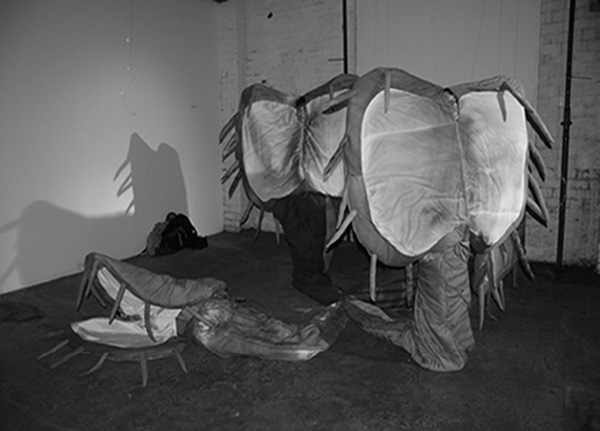
VENUS FLYTRAP
first performed on June 8, 2012
Glue Factory, Glasgow, UK
performed ten times in 2012
URARA TSUCHIYA
Jennifer Bailey, Alison Gibbs, Miranda Kayes, Paul Kindersley, Cedric Tai
371177881u371177881.371177881t371177881s371177881u371177881c371177881h371177881i371177881y371177881a371177881@371177881g371177881m371177881a371177881i371177881l371177881.371177881c371177881o371177881m
VENUS FLYTRAP
URARA TSUCHIYA
“Venus Flytrap” consists of one to four performers. The costume plays an important role in this performance. By wearing the huge soft sculpture costume, the performer is instantly given a role to play—a carnivorous plant. The audience becomes the flies and insects around the flytrap voluntarily or involuntarily; if they can manage to be somewhere safe from this type of participation, they can experience the role of spectator. My interest in this work is to challenge the viewer to negotiate his or her own personal and physical boundaries.
The bodies of the performers are connected through the costume. The costume creates a humorous monster figure that necessitates that the performers communicate with each other in order to coordinate movement.
I was interested in making costumes that can be mistaken as a soft sculpture in a gallery context. If the performers do not move, or move very slowly and mechanically, it looks like a sculpture. If the performers lie still and flat on the floor, no one suspects that people are inside. It can be performed by one performer who does not move much, who just sits quietly there and observes the audience. The audience would not notice until they come closer, and the face to face encounter is very awkward.
When performed by three or four people, the encounter is different. They can all follow the audience around and attack, the flytrap can move like a monster. Sometimes the flytrap likes gentle hugs, and other times the hug is never a hug—the plants don’t let the audience go, and might wrestle the audience member(s) to the ground.
The flytrap is not too mobile, so the size of the space determines what kind of relations between the flytrap and audience will have. For example, when performed in a small gallery space just enough to accommodate the full flytrap, the audience will not have much choice if they want to interact with it or not.